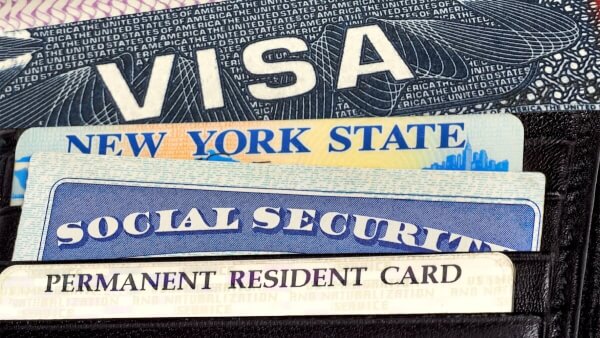Transferring your international driver's license to the US: step-by-step
Your full guide to updating your foreign driver's license to the US.

You may need to know about the Green Card Visa Bulletin if you’re in the process of applying for permanent residency on the basis of family relationships or employment in the US.
The Green Card bulletin doesn’t apply to all visa eligibility categories. You won’t need to worry about it if you’re applying as the spouse, parent or child under the age of 21 of a US citizen. However, if you’re applying on the basis of your relationship to a Green Card holder, as the sibling or married child of a US citizen, or on the grounds of your employment, this article is for you.
Dive in to get a full explanation of the Visa Bulletin including understanding your Green Card priority date and other key terms. You can also learn more about the Green Card here — and get all you need to know about applying for the Green Card on the basis of marriage, here.
| 📑Table of Contents |
|---|
The Green Card Visa Bulletin¹ is issued monthly by the Department of State, to help applicants for permanent residence in the US understand the likely wait times for their application. This is because caps on the numbers of Green Cards issued by category type and citizenship can make for backlogs — and long waits for some people.
Not all Green Card categories are capped. If you’re applying through an uncapped eligibility route, you don’t need to wait for a visa to come available. This applies if you’re applying as:
If you’re applying for a Green Card under any other route you’ll need to understand the Visa Bulletin to know when you can apply for adjustment of status using Form I-485².
Annual caps are placed on the number of Green Cards that can be offered within most eligibility categories, with applications assessed based on filing date³.
Within the caps there are also rules around how cards are distributed among application types, and by country of origin. At the time of writing the overall annual caps for family based Green Card applications are as follows:
| Preference number | Code | Eligibility reason | Annual Green Card Cap⁴ |
|---|---|---|---|
| First | F1 | Unmarried sons and daughters of US citizens | 23,400 |
| Second | F2A | Spouses and children of Green Card holders | 87,934 |
| Second | F2B | Unmarried children aged 21 or older of Green Card holders | 26,266 |
| Third | F3 | Married children aged 21 or older of US citizens | 23,400 |
| Fourth | F4 | Siblings of US citizens | 65,000 |
For employment based Green Cards, the worldwide level for annual employment-based applications is at least 140,000.
However, within the caps for both employment and family based applications there are also rules which place restrictions on applications from some countries. No country can account for more than 7% of Green cards issued in a given year. This means that there are longer wait times for people applying from larger countries, or from those where immigration to the US is common. At the time of writing this means you’ll have to wait longer for your Green Card if you’re from countries including China, India, Mexico, Philippines and Vietnam⁴.
The Visa Bulletin helps Green Card applicants figure out how long the backlog — and therefore how long the wait time — for their specific country of origin and visa type.
We’ll run through some key Visa Bulletin terms in just a moment. When you locate the current Green Card bulletin you’ll find a series of tables. Find the one relating to your application type — family based or employment based. If you’re already in the US you need the table referring to Final Action Dates — and if you’re not in the US yet, look out for the Dates For Filing table.
You’ll then need to find the preference code from the table above that applies to your application, and read right to find the right country column for you.
So if you’re from India and applying as an F3, you’ll find F3 in the left hand column, and scan right to find the column titled India. Here you’ll find a letter or date. If you have a priority date that’s earlier than the date in the table, you can proceed to the next stage of your application. If the table has a C in your field you can also proceed.
The table can be confusing at first, but there is a lot of explanation in the bulletin itself. We’ll look at what all the terminology means next.
Here’s some of the key terminology you’ll need when reading the Green Card Bulletin.
| Visa Bulletin word | Meaning |
|---|---|
| Priority date | This is the date that USCIS received your immigrant petition I-130. Check your Green Card priority date on the letter mailed back to you confirming receipt of your application — Form I-797 |
| Cut-off date | The cut-off date is the date shown in the Visa Bulletin. You can only apply for adjustment of status if your priority date is earlier than the cut-off |
| Final action date | Applications which have hit the final action date are ready for approval now |
| Date for filing | Use the date for the filing chart if you’re not in the US yet. These dates are earlier than the final action dates, to allow you to complete the other steps of the process needed by applicants outside the country |
| Current | If you see a C in your field on the Visa Bulletin, this means current. That’s good news as there is no backlog and you can apply for your Green Card now |
| Chargeability areas | Your chargeability area is your country of origin |
| Immediate relative | For visa purposes an immediate relative is a spouse, parent or unmarried child under the age of 21 |
| Visa retrogression | Usually the dates in the Visa Bulletin move forward — meaning the line is moving ahead. However, sometimes due to changes in circumstances, the date goes back instead. This is visa retrogression and means you’re in for a longer wait time |
The wait time after you submit Form I-485 can vary. The best option is to track your case online using the USCIS tracking tool⁵.
Your priority date is the date that your I-130 visa petition is received and approved by USCIS. This is the petition that is sent by your sponsor to kick off the Green Card application process.
It’s worth noting that you’ll only be issued a priority date once your I-130 is correctly submitted. If there are omissions or errors you won’t be given a priority date — or a place in line on the Visa Bulletin.
You’ll receive a priority date when your immigrant petition is received by USCIS. If you’re applying for an employment related visa and a Labor Certification was required, your priority date will be when this certification was approved.
When your sponsor sent in your immigrant petition, you’ll have received an acknowledgement and approval letter — Form I-797. Check your priority date here for reference.
Check the progress of your priority date by taking a look at the Visa Bulletin when it is released every month. You should see the dates progressing towards your priority date — like a line moving forward as you wait your turn.
There are several fees you’ll need to pay as you continue through the journey to receive your US Green Card. If you’re paying in a foreign currency, you could save money with Wise low cost international payments.
|
|---|
Getting your US permanent resident card can be a long process — with different steps to understand and navigate. Use this guide to help you get to grips with the Visa Bulletin — to help you track the progress of your application as you move through the line.
Sources:
Sources checked on 07.23.2021
*Please see terms of use and product availability for your region or visit Wise fees and pricing for the most up to date pricing and fee information.
This publication is provided for general information purposes and does not constitute legal, tax or other professional advice from Wise Payments Limited or its subsidiaries and its affiliates, and it is not intended as a substitute for obtaining advice from a financial advisor or any other professional.
We make no representations, warranties or guarantees, whether expressed or implied, that the content in the publication is accurate, complete or up to date.

Your full guide to updating your foreign driver's license to the US.

Whatever your reason is for moving to the US, this guide aims to help you figure out the most important costs you'll face when you live there.

Find all you need to know about getting a personal loan for H-1B visa holders in this guide.

Everything you need to know about the US certificate of naturalization.

The US welcomes large numbers of new arrivals every year — and getting a great job to both gain experience and set down roots is a core part of the American...

Find everything you need to know about the US citizenship test, including the USCIS questions and answers.